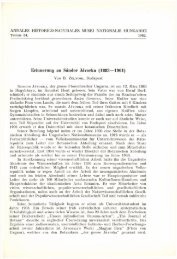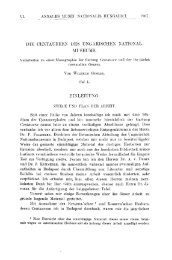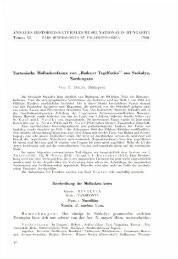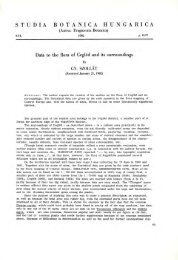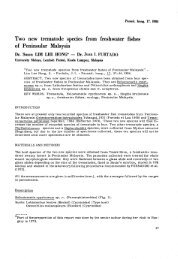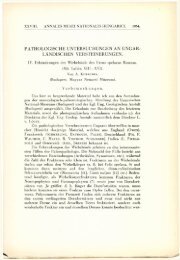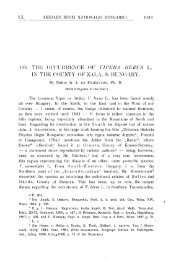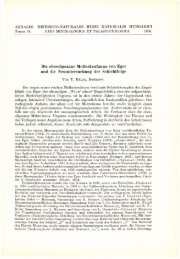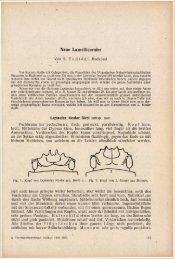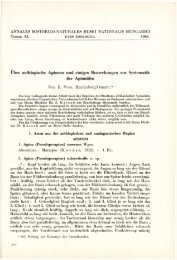Budapest 1984 - Magyar Természettudományi Múzeum
Budapest 1984 - Magyar Természettudományi Múzeum
Budapest 1984 - Magyar Természettudományi Múzeum
You also want an ePaper? Increase the reach of your titles
YUMPU automatically turns print PDFs into web optimized ePapers that Google loves.
ANNALES HISTORICO-NATURALES MUSEI NATIONALIS HUNGARICI<br />
Tomus 76. <strong>Budapest</strong>, <strong>1984</strong> p. 239-244.<br />
Flea species new for the Hungarian fauna (Siphonaptera), VII.*<br />
by A. DUDICH, Stare Hory & I. SZABÓ, <strong>Budapest</strong><br />
Abstract — Five flea species are reported new to the fauna of Hungary: Atyphloceras nuperus<br />
(JORDAN), Rhadinopsylla mesoides SMIT, Amalaraeuspenicilliger kratochvili ROSICKY, Doratopsylla<br />
dasyenema cuspis (ROTHSCHILD) and Nosopsyllus mokrzeckyi(WAGNER). Locality data, taxonomical<br />
remarks and zoogeographical evaluations are given for every species in question. With 16 figures.<br />
The following flea species new for the Hungarian fauna were obtained from the bodies<br />
of small mammals (insectivores and rodents) in the last two years:<br />
Atyphloceras nuperus (JORDAN) 1931 — L o c a 1 i t i es. 1 çf : Királyháza, Rózsáspatak vgy.,<br />
500 m (Börzsöny Mts., Com. Nógrád) 10 October 1983, leg. STOLLMANN, host : C. glareolus (SCHREB.).<br />
2 9 0 : Mátraalmás, 700 m (Mátra Mts., Com. Nógrád), 12-13 October 1983, leg. MÉSZÁROS and<br />
STOLLMANN, host: C. glareolus (SCHREB.). 2 9 9 : Nagyvisnyó, Bán patak vgy., 600 m (Bükk Mts.,<br />
Com. Heves) 16 October 1983, leg. STOLLMANN, host : C. glareolus (SCHREB.).<br />
This mountain species was first announced from the Western Carpathians by JURIK (1960).<br />
Since then we have found specimens from more than forty mountain localities that are above 700 m.<br />
It was ascertained that the area of distribution of A. nuperus in Central Europe basically corresponds<br />
with the natural distribution of fir-tree {Abies alba L.) (DUDICH 1983). Our material was collected<br />
in pure beech forests, but maybe, fir was certainly distributed in the mid-Holocene and probably<br />
also in historical times. A. nuperus as a stenochronous species is a member of the winter fleasynusia<br />
of the bank vole in the highest mountain sites in Hungary. For this reason hitherto it has not been<br />
detected. Our few specimens were sampled along with the following flea species: Ctenophthalmus<br />
agyrtes peusianus ROSICKY, Ctenophthalmus c. congener (ROTHSCHILD), Hystrichopsylla t. talpae<br />
(CURTIS), Peromyscopsylla b. bidentata (KOLENATI), Peromyscopsylla fallax (ROTHSCHILD), Rhadinopsylla<br />
integella (ROTHSCHILD). In the Mátra Mts. it has been found with Ctenophthalmus obtusus JORDAN<br />
et ROTHCHILD, Rhadinopsylla mesoides SMIT, and Amalaraeus penicilliger kratochvili RosiCKY.<br />
Indexes of infestation (calculated for the bank vole only) on the whole were low: extensity 1.8-<br />
2.4%, mean intensity 0.018-0.047. Low degree of dominance was calculated, too (D = 1.1-2.5).<br />
There were 183 specimens of C. glareolus and 71 specimens of other members of the family Arvicolidae<br />
(Pitymys subterraneus DESÉLYS-LONGCH. and Microtus arva/is PALLAS) examined totally.<br />
The occurrence of A. nuperus in Hungary can be expected in the Kőszeg Mts. (foothill of the<br />
Alps, in the western part of our country) and probably in the Zemplén Mts. as a continuation of the<br />
distribution of this species from Slovakia. Since A. nuperus was not mentioned in the volume of<br />
Siphonaptera — Fauna Hungáriáé (Szabó 1975) the morphological patterns necessary in the identification<br />
of this species are given (Figs. 1-4).<br />
Rhadinopsylla mesoides SMIT, 1957 — Locality. 1 çf '• Mátraalmás, Szuha patak vgy., 700 m<br />
(Mátra Mts., Com. Nógrád), 13 October 1983, leg. KOVÁCIK, host : C. glareolus (SCHREB.).<br />
This rare mountain species is distributed in the great European mountain ranges (Pyrenees, Alps,<br />
Carpathians and Balkan mountains). ROSICKY (1950) first recorded Rhadinopsylla mesa J. et R. from<br />
the High Tatra Mts. in the Western Carpathians. Since it is known only from a few localities in the<br />
Vihorlat Mts. (DUDICH <strong>1984</strong>a); Kremnické vrchy Mts. (JURIK 1960); Polana Mts. (DUDICH <strong>1984</strong>b);<br />
Western Tatra Mts. (DUDICH, 1982) and Javorniky Mts (RYBA et al. 1975) all the localities are in<br />
Czechoslovakia. Only single specimens of Rhadinopsylla mesoides had been collected rarely from the<br />
fur of the main host species, abundant collections were made from the winter-nests of the bank vole<br />
(Ryba et al. 1975). R. mesoides is a member of the winter-synusia of nests of C. glareolus (SCHREB.).<br />
Our only specimen was collected with other late autumn and winter flea species : A. nuperus (Jordan);<br />
* Report No. 10 from the project "Complex parasitological studies on small mammal populations", a co-operation<br />
between the Hungarian Natural History Museum, <strong>Budapest</strong> and the Institute of Experimental Biology and Ecology, Slovak<br />
Academy of Sciences, Bratislava.
A. penicilliger kratochvili ROSICKY; Peromyscopsylla fallax (ROTHSCHILD); R. integella (ROTHSCHILD);<br />
P. bidenatata (KOLENATI) and others. Because the main Slovakian localities are at an altitude between<br />
550 and 1000 m, it may be supposed that the species might occur in the mountains of Hungary.<br />
Since Rhadinopsylla mesoides was not included in the Hungarian fauna work, the morphological<br />
patterns of both sexes are given in Figs. 5-8.<br />
Amalaraeus penicilliger kratochvili ROSISKY, 1955 — Locality. 14 rfrfanà 16 $ $ : Mátraalmás<br />
Rudolftanya and Szuha patak vgy., 700-750 m (Mátra Mts., Com. Nógrád) 12-14 October 1983, leg.<br />
KOVÁCIK, MÉSZÁROS and STOLLMANN, hosts: C. glareolus (SCHREB.), M. arvalis (PALL.) and P.<br />
subterraneus DESÉLYS-LONGCH.<br />
This subspecies of A. penicilliger (GRUBE) is of mountain distribution in Central Europe and the<br />
Balkan peninsula. In the Slovakian part of the Western Carpathians on the whole it has a contimuous<br />
distribution. It does not occur in lowlands and hollows, therefore we suppose an isolated<br />
island-like population of A. penicilliger kratochvili in the Mátra Mts. In the neighbouring mountains<br />
on both sides of the Mátra it was not recorded in the same vegetation and at the same time. For the<br />
mid-October sample of A. penicilliger kratochvili the following indexes of infestation were calculated<br />
(for the C. glareolus only): extensity 14.4%; mean intensity 0.27 and dominance 15.0.<br />
The occurrence of A. penicilliger kratochvili in Hungary may be expected in the Zemplén Mts.<br />
as a continuation of the distribution from the Slovakian part and in the western part of our country<br />
—in the foothills of Alps—now. In the Mátra Mts. both congeneric species of the genus Amalaraeus<br />
occur together {A. arvicolae IOFF was recorded by HAITLINGER 1973), therefore figures to show the<br />
variability of the 7th sternum and the patterns of internal genitalia of females of both species are<br />
given (Figs. 9-11 ). The separation of the females is based on that ambiguous patterns published in the<br />
key (SZABÓ 1975) is quite impossible since the shape of patterns overlap.<br />
Doratopsylla dasyenema cuspis ROTHSCHILD, 1915 — Locality. 6 ç?ç? and 8 9 9- Kishuta,<br />
Rostalló, 450-500 m (Zemplén Mts; Com. Borsod-Abaúj-Zemplén), 11-14 November 1982, leg.<br />
Figs. 1-4. Atyphloceras nuperus (JORDAN): 1 = head and pronotum of male (after Smit), 2 = clasper,<br />
3 = phallosome and 9th sternum, 4 = outline of sternum 7 of female. — F-ig. 5. Rhadinopsylla<br />
mesoides SMIT : a = head of male and b = head of female
DUDICH, MÉSZÁROS and STOLLMANN, hosts: S. araneus L.; N.fodiens (PENN.), M. arvalis (PALL.) and<br />
A. flavicollis (MELCH.).<br />
The occurrence of the eastern, mainly mountain, subspecies of D. dasyenema (ROTHSCHILD) was<br />
expected only from the mountainous parts of eastern Hungary (SZABÓ 1975, 1980). This subspecies<br />
occurs in Slánske vrchy Mts. in Slovakia (on its Hungarian side the abovementioned material was<br />
collected), in the Eastern Beskid mountain range and in the Vihorlat Mts. (DUDICH <strong>1984</strong>a) but no<br />
specimen was found in the Thais lowland in Slovakia nor in Hungary. D. dasyenema cuspis may<br />
occur in Hungary now in the entire eastern part of the country as a possible continuation of its distribution<br />
from the mountains of Roumania (Bihor Mts.). Namely, westwards from the locality mentioned<br />
above, in the Slovakian part of the Aggtelek karst (Slovensky kras) and in the Bükk Mts. we<br />
know the nominate form only. So the valley of the river Hernád seems to be a natural barrier in the<br />
distribution of the two subspecies today.<br />
The following indexes of infestation were observed (calculated for the two shrew species only):<br />
extensity 17.1 %; mean intensity 0.35 and dominance 23.5.<br />
Our specimens were collected together with the following taxa from the eastern province:<br />
Ctenophthalmus agyrtes kleinschmidtianus PEUS; Palaeopsylla sor ici s s tar ki WAGNER and Hystrichopsylla<br />
o. orientális SMIT.<br />
The morphological patterns of the males from the Zemplén Mts. are "clear cuspis" found in the<br />
Slovak Eastern Carpathians (Fig. 12), but the outline of the 7th sternum in the females is highly<br />
variable owing to the introgression influence between the two subspecies along the border of their<br />
distribution area (Fig. 13).<br />
Figs. 6 -7. Rhadinopsylla mesoides SMIT: 6 = clasper and sternum 9 and 7 = phallosome of male<br />
—• Fig. 8. Rhadinopsylla mesoides SMIT: outline of sternum 7 and spermatheca of female •— Fig. 9.<br />
Amalaraeus penicilliger kratochvili ROSICKY: outlines of sternum 7 of females (Mátra population).<br />
— Fig. 10. Amalaraeus arvicolae (IOFF) : outline of sternum 7 of female (Bükk population)<br />
16 <strong>Természettudományi</strong> <strong>Múzeum</strong> Évkönyve <strong>1984</strong>
Nosopsyllus mokrzeckyi (WAGNER, 1916) — Locality. 1 $ : Hortobágy (Great Pannonian<br />
lowland, Com. Hajdú-Bihar), August 1943, collector unknown (OKI, deposited in HNHM. <strong>Budapest</strong>,<br />
No. 120), host : M. arvalis (PALL.).<br />
A single specimen of N. mokrzeckyi (WAGN.) was found among a longer series of N. fasciatus<br />
(Boso) collected on the common vole in the most remarkable steppe region in the Pannonian lowland.<br />
The occurrence of this species was not confirmed recently in the same region (SZABÓ 1981). The recent<br />
distribution of N. mokrzeckyi in Central Europe and the Balkan peninsula is little known. It occurs in<br />
Yugoslavia. Roumania and the European part of the USSR in the primary steppe region (Sucru 1973;<br />
YURKINA 1961). The first finding in the Carpathian Basin was reported by JURIK (1962) in the Slovakian<br />
part of the Danube lowland on the house mouse (Mus musculus L.) in a village habitat. According<br />
to this author the possibility of an anthropogenous transport of the parasite with synanthropic<br />
rodents, via the Danube, in historic time should be considered. In the flea collection of the Entomological<br />
Division of the Slovak National Museum in Bratislava we recently found a further specimen<br />
Fig. 11. Duct of bursa copulatrix: in a = Amalaraeus penicilliger kratochviliROSICKY and b = Amalaraeus<br />
arvicolae (IOFF) (after Smit). — Figs. 12-13. Doratopsylla dasyenema cuspis (ROTHSCHILD):<br />
12 = terminalia of male, 13 = outlines of sternum 7 and spermatheca in female. — Figs. 14-16.<br />
Nosopsyllus mokrzeckyi W'AGNER): 14 = clasper and sternum 9 of male (Tek ovské Luzany, Slovakia),<br />
15 = tergum 8 of the male, 16 = outline of sternum 7 and spermatheca of female (Hortobágy)
of N. mokrzeckyi from another locality close to Jurik's (DUDICH & MATOUSEK <strong>1984</strong>). Finally, one<br />
misdetermined specimen was also found in the OKI, now deposited in the HNHM, <strong>Budapest</strong> originating<br />
from Slovakia, prepared on a slide with two specimens of Leptopsylla segnis (SCHÖNHERR). 1 çf,<br />
locality: Tekovské Luzany (formerly Nagysalló, as labelled on the slide); Danubian lowland, September<br />
1923, leg. Dudich, host: Mus musculus (hortulanus) L. (OKI deposit No. 94). This specimen<br />
had been identified as N.fasciatus (Bosc). and this name was introduced in SULYOMI'S (1944) thesis.<br />
With the exception of Hortobágy, all Pannonian specimens were collected from the fur of the<br />
house mouse. This fact by our opinion does not exclude the possibility of autochthonous occurrence of<br />
N. mokrzeckyi in Hungary and in adjacent countries within the Carpathian Basin. This species<br />
undoubtedly belongs to the steppe faunal complex along with other fleas of steppe mammals [Citellophilus<br />
and Neopsylla from the ground squirrel ; Ctenophthalmus caucasicus (TASCHENBEFCG) from the<br />
mole rat and so on]. Nosopsyllus mokreckyi (WAGNER) was not included in the Hungarian fauna in<br />
the volume of Siphonaptera. therefore, we give the distinguishing patterns of terminalia for both<br />
sexes (Figs. 14-16).<br />
DISCUSSION<br />
As the result of our study the Hungarian flea fauna increases by live new taxa, so the<br />
total number of the known species and subspecies is now 68. With the exception of Palaeopsylla<br />
steini JORDAN we have completed the Hungarian flea fauna by the heretofore unrecorded<br />
species of the mountain fauna complex according to ROSICKY (1967). From among<br />
the species of the boreo-montane province, i.e. taiga faunal complex includes Ctenophthalmus<br />
u. uncinatus (WAGNER), Rhadinopsylla integella (ROTSCHILD) and we suppose with a high<br />
degree of probability of the occurrence of Peromyscopsylla silvatica (MEINERT) in the northern<br />
part of our country as a continuation of its range of distribution from Slovakia. It was<br />
collected not far from the border, in the Slovak Karst region. So the Hungarian Northern-<br />
Mountains, east of the Danube, have the same fleafauna compositions deriving from small<br />
terrestrial mammals as have the Polish or Slovak Western Carpathians-—with the exception<br />
of the boreo-alpine species as are Amphipsylla sibirica and Megabothris rectangulatus. These<br />
species have very limited distribution in the Carpathians and occur in the highest mountains<br />
having primarily at least a subalpine zone.<br />
References<br />
DUDICH, A. (1982): Annotated survey of small terrestrial mammal ectoparasites on Orava (North<br />
Slovakia, Western Carpathians) Part. 1 Fleas, Siphonaptera. — Oravské múzeum. 2: (1983)<br />
38-53.<br />
DUDICH, A. (1983): Paläomontane Zusammenhänge der nacheiszeitlichen Verbreitung einiger<br />
floristischer und faunistischer Elemente in Mitteleuropa. — Abstract of lectures of X. STEEC.<br />
<strong>Budapest</strong>, p. 14.<br />
DUDICH, A. (<strong>1984</strong>a): Fleas (Insecta. Siphonaptera) of small mammals in Vihorlat Mts. (Eastern<br />
Carpathians). — Zbornik Vychodoslov. múzea v Kosiciach, Prirodné vedy, 23: (1983) 153-181.<br />
DUDICH, A. (<strong>1984</strong>b): Contribution to the knowledge of fleas (Insecta, Siphonaptera) of the Kremnické<br />
vrchy Mts. 1. Fleas of the small terrestrial mammals. — Kmetianum, 4: in print.<br />
DUDICH, A. (<strong>1984</strong>c): Fleas (Siphonaptera) of insectivores and rodents (Mammalia: Insectivora.<br />
Rodentia) of Protected Landscape Region Pol'ana. — Ochranaprirody, 5: in print.<br />
DUDICH, A. & MATOUSEK, B. (<strong>1984</strong>): Fleas (Insecta: Siphonaptera) from the collection of Slovak<br />
National Museum in Bratislava. — Acta rer. nat. mus. nat. Slov. (Bratislava), 60: in print.<br />
HAITLINGER, R. (1973) : To the knowledge of Siphonaptera and Anoplura fauna of the small mammals<br />
in Hungary. — Parasitai, hung., 6: 205-213.<br />
JURIK, M. (1960): Aphaniptera of the Badinsky prales primeaval forest (Kremnické hory Mts.)<br />
— Biológia (Bratislava), 15: 847-849.<br />
JURIK, M. (1962): Contribution to the knowledge of Aphaniptera in Czechoslovakia. II. (Nosopsyllus<br />
Jordan, 1933). — Biológia (Bratislava), 17: 383-388.<br />
ROSICKY, B. (1950): A provisonal catalogue of the fleas (Aphaniptera) from the territory of Slovakia.<br />
— Prirodovedny zbornik SA V(Bratislava), 5: 155-171.
ROSCIKY, B. (1967): Entomogeographical division of Central Europe and Balkan Peninsula based on<br />
order Aphaniptera. — Proc. II. Entomofaun. Symp. Opava, p. 227-241.<br />
RYBA, J. &. ROSICKY, B. (1975): Rhadinopsylla (Actenophthalmus) mesoides Smit, 1957 (Siphonaptera<br />
Hystrichopsyllidae) in Czechoslovak Western Carpathians. — Folia parasitol. (Praha).<br />
22: 379-383.<br />
RYBA, J., ROSICKY, B., DANIEL, M. & MRCIAK, M. (1975): Siphonaptera of small terrestrial mammals<br />
and their nests in the Western Carpathians. — Folia parasitol. (Praha), 22: 45-56.<br />
Suciu, M. (1973) : Catalogue of the Siphonaptera from Rumania. — Mus. Stiin. Nat. Bacau, 6: 47-42.<br />
SULYOMI, K. (1944): A magyarországi bolhák. (The fleas of Hungary). — Thesis. <strong>Budapest</strong>, p. 1-117.<br />
SZABÓ, I. (1975): Bolhák. Siphonaptera. — Fauna Hungáriáé, XV:18: 1-97.<br />
SZABÓ, I. (1980): The borders of the distribution of certain subspecies of fleas in Hungara. — In:<br />
TRAUB, R. & STARCKE, H. (Ed): Fleas. Proc. Int. Conf. of Fleas. Ashton Wold (Peterborough)<br />
(UK) 21-25 June 1977, A. Balkema-Rotterdam, p. 379-382.<br />
SZABÓ, I. (1981): The Pleas (Siphonaptera) of the Hortobágy National Park. -- Tlie Fauna of the<br />
Hortobágy National Park. I. <strong>Budapest</strong>, p. 243-244.<br />
YURKINA, V. Í. (1961): Blochi. Fauna Ukrajnii. (Fleas. Fauna of Ukraine). — Kiev, p. 1-152.<br />
Authors's address: DR. A. DUDICH<br />
Institute of Experimental Biology and Ecology<br />
Slovak Academy of Sciences, Research Station<br />
CS-97 602 Stare Hory<br />
Czechoslovakia<br />
I, SZABÓ<br />
Fazekas utca 4<br />
H-1015 <strong>Budapest</strong><br />
Hungary



